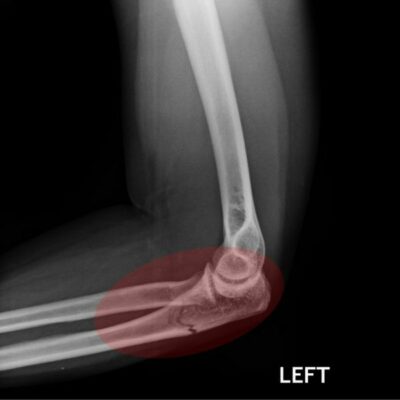Elbow Fracture Specialist

Have you suffered a fracture of the elbow? A broken elbow can occur from direct impact to the elbow, a fall, or a twisting injury to the arm. Symptoms of a fractured elbow include intense pain, tenderness, and swelling in and above the elbow. Fractured elbow specialist, Dr. James Mazzara provides diagnosis and both surgical and nonsurgical treatment options for patients in Manchester, South Windsor, Enfield, Glastonbury and surrounding Hartford communities who have suffered an elbow fracture. Contact Dr. Mazzara’s team today!
What are fractures of the elbow?
There are many bones in and around the elbow joint that can break or fracture. Fractures of the elbow area may result from direct impact to the elbow, a fall, or a twisting injury to the arm. Sprains, strains or dislocations may occur at the same time as a break. Dr. James Mazzara, elbow specialist serving Manchester, South Windsor, Enfield, Glastonbury and surrounding Hartford communities treats patients with fractures of the elbow area. He classifies these breaks as follows:
- Open – meaning the bone has broken through the skin.
- Closed – the bone is broken inside the elbow, beneath the skin.
- Displaced – bones are broken in two or more pieces and do not remain in contact with each other.
What are the types of elbow fractures?
The elbow is a hinge joint that allows you to move your forearm back and forth, as well as rotate the palm upward and downward. The elbow joint connects the humerus (upper arm bone) to the radius and ulna (lower arm bones that make up the forearm.) A fracture may occur in any of the bones that form the elbow. The different types of fractures of the elbow area are:
- Olecranon fractures: The olecranon is the bony tip of the elbow, felt when bending the arm. It is not covered by muscles or ligaments, so it’s especially vulnerable to fracture if the elbow makes direct contact with a hard surface. It can break easily from a direct blow or falling on an outstretched arm.
- Symptoms include sharp pain, swelling, tenderness and an inability to extend the elbow. The broken bone may also cause a visible protrusion beneath the skin.
- Radial head fractures: The radius is one of the bones in the forearm. The radial head meets the humerus (upper arm bone) at the elbow joint. A fracture of this bone may occur when falling on an outstretched arm. An elbow dislocation can also put stress on the radial head, leading to a fracture.
- Symptoms include pain when extending the elbow, swelling, and difficulty rotating the forearm. Turning the palm up or down may be painful.
- Distal humerus fracture: The distal humerus is the bottom part of the long arm bone that connects the elbow to the shoulder. In the elbow, it rotates against the radial head and the ulna, forming the upper part of the elbow joint. Fractures of this bone are relatively uncommon but can occur with a blow to the elbow or falling directing on a bent elbow. Breaking a fall with a straight extended hand can also lead to fracture.
- Symptoms include intense pain, tenderness, and swelling in and above the elbow. The elbow might not be able to extend completely. The joint could feel weak or unstable, especially if attempting to pick up an object or putting any king of weight on the affected arm.
How are fractures of the elbow area diagnosed?
For patients in the Manchester, South Windsor, Enfield, Glastonbury and surrounding Hartford communities, Dr. Mazzara will ask about the medical history, symptoms and conduct a general health assessment. The elbow will be examined to determine the extent of injury. Dr. Mazzara may also examine the shoulder, upper arm, forearm, wrist and hand to ensure there are no other injuries. The use of x-ray will help show the broken bone and he may request an MRI if he feels there is soft tissue damage that needs assessment.
How are elbow fractures treated?
Elbow fractures require immediate care to heal and prevent permanent damage to the bone or surrounding muscles, ligaments and other soft tissues.
How to treat elbow fractures without surgery?
If the pieces of bone are not displaced (out of normal alignment) a brace or cast can sometimes be used to hold the elbow in place while it heals. Casts are used more frequently in children, as their risk of developing elbow stiffness is small; however, in an adult, elbow stiffness is much more likely. Dr. Mazzara will recommend physical therapy to decrease the chances of elbow stiffness and to regain range of motion.
How to treat elbow fractures with surgery?
Elbow fractures often require surgery, especially if the bones have moved out of place or if there is an open fracture (when pieces of bone have punctured the skin.) Depending on the severity of the injury, Dr. Mazzara may do an arthroscopic or an open repair. Surgery for fractures of the elbow area typically involve putting the pieces of bone back into their normal anatomical position and using pins, wires, screws or strong sutures to keep them in place while they heal. Dr. Mazzara may use one of the following surgical techniques:
- Open reduction and internal fixation: Used most often for olecranon fractures, bone fragments are repositioned (reduced) into their normal alignment and the pieces of bone are then held in place with screws, wires, pins, or metal plates attached to the outside of the bone.
- Bone graft: Serious fractures can crush the bone or cause bone pieces to be lost through an open wound. Dr. Mazzara can use a bone graft can be taken from a donor (allograft) or from another bone in the patient’s body (autograft)—most often the hip. In some cases, an artificial material can be used.
- Removal of the fractured fragment: If the patient has bone fragments too small to repair, the pieces are sometimes removed. Depending on the bone broken (most often olecranon) Dr. Mazzara can use a bone graft, or he can reattach the triceps tendon to the remaining portion of the ulna.
- External fixation: If the injury has caused the elbow to dislocate, internal fixation may not be the most effective treatment option. This type of injury can make setting the bone more difficult. In these rare cases, Dr. Mazzara will use an external fixation device, which is worn outside the body, to keep the bone fragments from moving and to prevent the elbow from dislocating again. The device is a hinged metal frame that surrounds the injured elbow that will stabilize the fracture using wires or pins inserted through the skin. After a period of healing, the device is removed.
How long does it take for fractures of the elbow area to heal?
Most patients can return to their normal activities within 4 months, although full healing can take up to a year. Some patients with other underlying health issues take longer to heal. Physical therapy is always recommended by Dr. Mazzara once proper healing has occurred and been verified by x-ray. It is not unusual for patients to have limited movement, especially with serious fractures. Regaining strength in the muscles and full range of motion will take time.
For more information on fractures of the elbow area, please contact the orthopedic office of Dr. James Mazzara, elbow specialist, serving patients living in Manchester, South Windsor, Enfield, Glastonbury and surrounding Hartford Connecticut communities.
